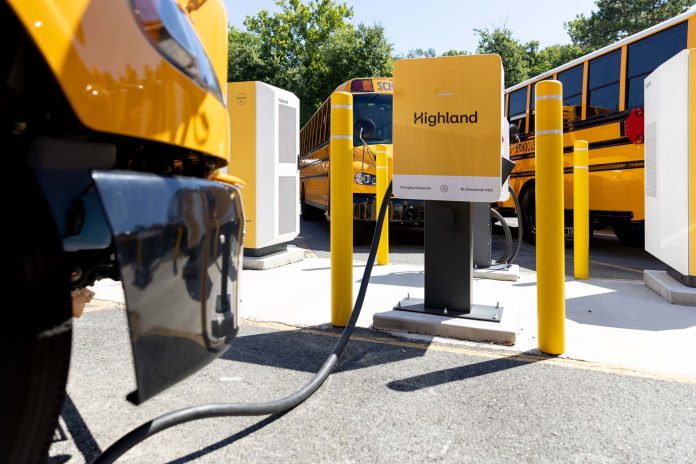While the jury is out on whether or not it will affect inflation, the Inflation Reduction Act (IRA) that President Joe Biden signed into law on Aug. 16 offers more funding for school bus electrification.
Although it does not prioritize and specify funding for school buses like the Environmental Protection Agency’s Clean School Bus Program implemented with the signing into law of the Infrastructure Investment and Jobs Act, the IRA makes school buses eligible for electrification funds through a new Clean Heavy Duty Vehicles program run by the EPA as part of the Clean Air Act.
The new program includes $1 billion for medium and heavy duty commercial electric vehicles, charging infrastructure and related workforce training. Class 6 and 7 school buses are eligible, the law notes, a provision that advocates worked hard for, explained Jaron Goddard, a clean energy lawyer with the Energy & Climate Solutions group at Wilson Sonsini Goodrich & Rosati in Seattle. Goddard is also a former counsel and climate staffer for Sen. Patty Murray of Washington.
IRA includes $400 million designated for air quality non-attainment zones, which cover many urban school districts including those in Los Angeles, New York and Chicago. The funds are allocated this year but available until 2031, and the program is supposed to launch within 180 days of the bill’s enactment.
Still, it remained unclear exactly how the $400 million would be spent. The same goes for the remaining $600 million.
“The legislative text leaves it a little open,” said Jennifer Rennick, senior manager for federal transportation electrification policy at the World Resources Institute. “We assume it will be competitive, that’s how the EPA has tended to run these programs.”
Goddard said stakeholders will be closely watching the government guidance that is issued for clarifications as to who is eligible for the funding under the Inflation Reduction Act. The law says that non-profit school transportation associations, contractors, municipalities, states, and Indian tribes are eligible. The Clean School Bus Program, by contrast, specified state and local governmental entities responsible for school bus service, eligible contractors, tribal schools, and nonprofit school transportation associations.
“These distinctions may seem minor, but there are some key differences, like some public school districts themselves may not be able to apply for the IRA program, but nonprofit school transportation associations can, for example,” Goddard said.
“The biggest thing is [districts and transportation contractors] will be competing with other eligible entities, and eligibility for the heavy-duty vehicles program is a little different, as well as this only being $1 billion as opposed to $5 billion” than the Clean School Bus Program, Goddard added. Additionally, “funds can be used for workforce development and training and charging infrastructure. It will be useful for schools to compare and contrast what exactly they are looking for – just the bus or other things they could leverage with those dollars.”
The Clean School Bus Program’s first round — the application deadline was Aug. 19 — is offering rebates for electric buses, with districts meeting equity criteria eligible for selection through a lottery. Once those priority applications are awarded, districts that don’t meet the equity criteria could have a chance to access any remaining funds, though experts expect non-priority districts will have to wait for future rounds of EPA funding.
Lawmakers and school district superintendents have criticized the way the program defines priority equity districts: those that have more than 20 percent of students living in poverty, based on the U.S. Census Small Area Income and Poverty Estimates. This definition leaves out Chicago, for example, and other districts with many low-income students.
For school districts that meet the criteria, the Clean School Bus Program rebates offer up to $285,000 and $375,000 for class 6 and 7 electric buses, respectively. Those figures are roughly the cost of a new bus.
The Clean Heavy Duty Vehicle funds, by contrast, will cover the incremental cost difference between a new electric and diesel vehicle, while also offering funds for charging infrastructure and training.
Manoj Karwa, director of worldwide sales for Rhombus Energy Solutions, said that the Inflation Reduction Act funding should be “really helpful.”
“It appears the local states will be interpreting this [and] there may be different interpretations,” he continued. “I understand it will roll down to states and they’ll make their own decisions. A challenge as a manufacturer is that every state may interpret it differently.”
Rennick said states should view the federal program as motivation to develop their own initiatives for vehicle electrification.
“It cannot only be top-down from the federal government, nor can it be bottom-up from the states. We need the marriage of the two. We need action from Congress, which has happened not once but twice [recently on the issue of clean vehicles],” she said. “And we need leadership at the state that helps with things like tech assistance. There are many things required in addition to just cutting a check.”
Related: Green Bus Summit Panel Examines Leading Challenges of Fleet Electrification
Related: Electric School Buses Expected to Remain Unaffected by SCOTUS Ruling Against EPA
Related: California Budget Provides ‘Historic’ Funding to School Transportation, Questions Remain
The IRA also creates $40,000 tax credits for clean vehicles weighing over 14,000 pounds, and $7,500 tax credits for lighter vehicles. School districts that don’t pay taxes can get the $40,000 as a direct payment, or a transferable credit.
The new commercial vehicle tax credit can be claimed for either 30 percent of an electric school bus, or the incremental cost between an electric and conventional bus for a value of up to $40,000 for Class 6 or 7 buses. Further, credits claimed under this new tax provision require that the bus be assembled in North America. A tax credit of up to $100,000 is also available for a “single item” charging infrastructure, which will require further federal agency guidance to assess what details in the new law mean.
In a report, Beia Spiller, director of the transportation program at the group Resources for the Future, noted that electric cargo vans are likely the only vehicles that would see their full costs covered by the tax credit.
“Districts should be getting together with their CFOs, working through how they can best take advantage of direct pay and transferability,” Goddard said. “How do we stack these on top of each other to make these buses as affordable as possible?”
Rennick noted that IRA funds should only be viewed as the latest incentives. “Forty thousand won’t get you a free bus; the intent is to make it a little easier as everyone is going forward and purchasing and bringing these buses online. It’s one more tool in the toolbox for schools looking to finance these buses.”
Goddard suggested that while districts could likely take advantage of the vehicle and charging tax credits and the grant funds under the Inflation Reduction Act, the federal government doesn’t typically allow double-dipping between programs – meaning a district might not be able to benefit from both the Clean School Bus Program and IRA funding for the same buses. “Given these overlapping grant and rebate funds and tax credits, it will be important to just be mindful of how you’re leveraging them together.”
An EPA representative over the summer before the passage of IRA confirmed to School Transportation News that no other federal funds could be added to a Clean School Bus Program award. However, recipients can piggyback on local or state grants, if those additional funds do not originate from the federal level.
Spiller noted that buses often drive significantly fewer miles than commercial trucks that would be eligible for the same program, meaning the money districts save on fuel each year won’t be as notable as the savings for delivery or other commercial operations.
However, “One benefit districts have compared to commercial companies like Amazon and Fedex, is with school buses they don’t have that restriction of making their money back in three to five years,” she said. “They have a longer time frame to recover their costs.”
Spiller and others emphasized that in addition to grants the IRA and Clean School Bus Program might provide, districts can help recoup their investments in electric school buses by using them to send power back to the grid.
“They can make money over the summer by selling their electricity from batteries back to the grid,” Spiller said. “This does require the utility to allow for these investments, and it requires coordination among the regulators, and wholesale markets, to make sure buses are allowed to participate. If they can come to an agreement, we will see more and more electric vehicles being adopted.”
At least three school bus vehicle-to-grid (V2G) pilot projects have been underway nationwide. The project in Beverly, Massachusetts completed at least 30 electricity power transfers from school buses to the grid over the past two summers
Karwa noted that districts should keep the possibility of such V2G services in mind if they are aiming for funding for charging infrastructure under the IRA or Clean School Bus Program. Districts would need to make sure they have bidirectional charging infrastructure to be able to send electricity back to the grid as well as charging.
“A single school bus can charge a home for a week,” Karwa said, adding that a Rhombus customer in Massachusetts is making $10,000 per bus over the summer for sending stored electricity back to the grid with Rhombus’s fast-charging DC bi-directional system. “If you don’t need it today, someday you will need it. Whether it’s a natural disaster or national security issue or monetization issue, you have this ability to decentralize the grid.”
Related: First West Coast School Bus V2G Pilot Project to Begin
Related: N.Y. Deploys First Type-C, Vehicle-to-Grid School Buses
Related: The Benefits of Electric School Buses, V2G for Low-Income Communities

















